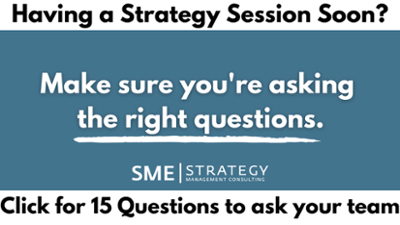
SME Strategy is a strategy consulting firm that specializes in helping organizations align their teams and operations around a shared vision, mission, values, goals, and action plans. Our strategic planning services offer guidance on how a strategic planning facilitator can provide support in constructing an effective strategic plan that ensures your strategy is communicated and implemented across your entire organization.
Given the troubling and unprecedented times we're living through today, we at SME Strategy are doing what we can to help prepare you and your organization for any type of uncertainty, economic slowdown, virus, natural disaster, and everything in between.
Below is a video that will break down the scenario development process, and walk you through each step in process. If you'd like to just read about the process or follow along, a transcription of the entire video is directly below. Thanks for watching!
Hey everyone, Anthony Taylor from SME Strategy here. Today, I want to talk to you about the scenario development process. At this point in time, it's April 2020, and a lot of people are dealing with COVID-19 and all the changes to their businesses or organizations. I wanted to make a re-recording of this video to support you in understanding scenario planning, understanding how you can use it, and showcasing a few different approaches of how you can develop scenarios for your business.
Fundamentally, the scenario development process is developing alternative scenarios to support you in dealing with what you're dealing with. First, you want to try to identify the driving forces, then you want to identify the critical the critical uncertainties - so what are the biggest trends that are impacting you and your organization. Then you want to create alternate scenarios, so basically four different worlds based on those extremes, and then discuss the implications or the paths of each of those. So what will that mean for your organization and how will it impact you?
We can help you align your team around a clear vision, mission, values, goals and action plans,
so you can lead your organization more effectively and get better results.
So why do you do scenario planning, and what is the point of it in the first place?
We can assume that the future is only going to happen one way - that it's going to be where we are now, and it's probably going to get to one exact point in the future. We're trying to get from point A to B, and it's going to be a clear, linear path and everything is going to be great. But in real life, what might happen is there's actually going to be a bunch of different potential scenarios that we might have to deal with, and so we want to make a plan so that if, at any fixed point in time, it could be one of those four different versions. So basically, we don't want to put all of our eggs in one basket because we're not very good at predicting the future. We want to anticipate a couple different alternatives in a range of potential scenarios and look at what those potential implications could be for our business or our organization.
If we go back to the model, the first step is identifying the driving factors. To do that, we use a tool called a PESTLE analysis. It looks at trends or drivers in your industry or organization that might impact your business. So, depending on what year you're in right now, or if you're in 2020, you'll want to look at a certain time frame. Depending on the style of organization and your approach, you might have a different time frame. You might be doing scenario planning for several years down the road, 10 years down the road, or even 25 years if you're planning for a city. But if you're planning for a small business, you might want to look at a year to three years in advance. I would recommend typically one to three year trends because of the pace of change. Then, it'll help you plan better scenarios and be more accurate. What you want to do is to look at the different trends in each of those areas, and identify them specifically.
So let's say you're doing this in a workshop. You can put up different post-it notes up for each. Let's say political - maybe there's a polarization of different groups, maybe there is a change in your local or federal or provincial government or state government that might impact what you're doing. Anything that has to do with the politics of your specific environment or the environment of your stakeholders.
> Watch below: Scenario Planning for a Post-Pandemic Future w/Lance Mortlock from EY
For economic, we're heading into probably a recession in the next little while. People's disposable income is smaller, increased household debt, probably going to be a greater propensity for people to save, the interest rate is almost 0 - those are all trends and things that we can imagine are happening, even if we're not specific about what those things are.
Social - there's the physical distancing, the social distancing, people are more so using visual tools, people are on Instagram and social media more, however people are spending their time - anything having to do with society or people.
Technological is anything having to do with technology, so probably an increase in AI, machine learning, fintech, that kind of stuff, and then anything that applies to your specific industry or organization, and how it applies to your situation and the situation of your stakeholders.
Legal - what are some laws or regulations that might impact how you do things or how your stakeholders might be impacted in the world of laws.
The final section is environmental or the environment. What changes in the environment, climate change, natural disasters, anything like that, how does that impact your business or your organization. More precisely, how will it impact that in the future.
So that's the first step in identifying the driving forces. The next step is identifying the critical uncertainties. If we look at this scenario planning template, I've taken the liberty of picking a couple that could potentially be accurate.
One of them (on the left side of the x-axis) is that we go back to being physically close, as in there are no bans related to physical distancing - you can shake hands and all that stuff. The other extreme (on the right side of the x-axis) is that we're fully remote, as in we stay fully remote for the next 2 or 3 years. On the y-axis, were looking at two scenarios - one is the economy goes into a recession, and the other is a healthy, growing economy. So fundamentally, it creates four distinct universes. One world where we're physically close and the economy is growing (top left quadrant), another where we're fully remote and the economy is growing (top right quadrant), another is we're physically close and there's a recession (bottom left quadrant), and another where we're fully remote and there's a recession (bottom right quadrant).
Each of those are going to have descriptors attached to it. You could describe each of these as if it were an alternate universe. Imagine you took a time machine and somebody dropped you into the year 2025 - we're super physically close and the economy is growing. You probably thought of 2018 when there were less problems and everybody was going about business as usual. Whereas if you were dropped into 2025 - everybody is remote and the economy is way down, what does that look like? Not necessarily just how it impacts your business, but how it impacts all of the 6 forces (political, economic, social, technological, legal, environmental). What does that mean for the world, and what does that mean for your business? Similarly, there's probably a version where we're physically close and there's a recession - describe that in all of those ways.
So what we're doing here (3rd step in the diagram), is developing all of those plausible scenarios once we've identified the scenarios in the first place.
The last piece in the scenario planning process I want you to think about - and a different approach you can use, is business as usual/best case/worst case scenario. You could use it by looking at each of the 6 forces (PESTLE), to identify what are the best case/worst case/business as usual cases for each area - as a means of describing it.
Instead of looking at the four different scenarios, you're basically saying if we move our business forward in 2022/2023/2025, what would the business as usual scenario look like for each factor of the PESTLE. What would be the worst case scenario, and what would be the best case scenario? You can expand that to the nth degree, but what that does is discuss the implications and paths of scenario planning and how it moves forward.
So if you're trying to incorporate scenario planning to both predict the future and adapt on how you can move forward - first you want to identify all the driving forces or the trends. Next you want to identify the critical uncertainties - what are the top 2 drivers for your organization that you want to prioritize? From there, develop the 4 potential scenarios based on those extremes, and real life will probably fall in one of those 4. Keep in mind it could move from one sector to another as time goes on. Lastly, discuss the implications and paths of those scenarios as you move forward and how you need to address those challenges and what you need to do to be successful with those challenges as an organization.
My name's Anthony Taylor, this has been a video by SME Strategy - I really hope it helps you develop a scenario plan and helps your business be successful in this time. If you're looking for a strategic planning consultant to facilitate one of these conversations with you as a team, to guide you through the process and help you create not only the scenarios, but action plans on how to move forward, please reach out to us here - we offer services for virtual strategic planning facilitation.
Be sure to subscribe to our channel on YouTube, where we'll be putting out more videos like this to help you and your business be successful, have a future that you can see, and an action plan to get there.
Thanks again, and we would appreciate your feedback in the comments, and if you have any questions - we're happy to answer them as well.
Take care, everyone.
For a visual summary of the scenario planning process:





